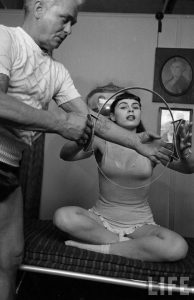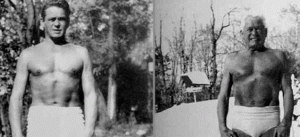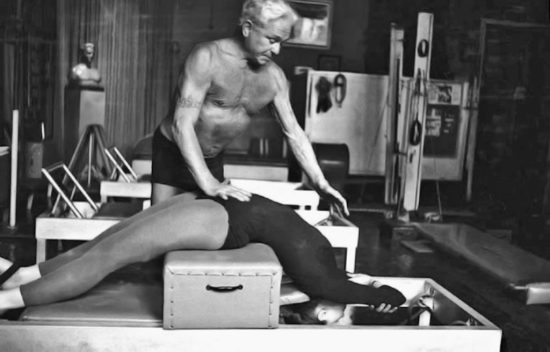“You can’t get away from it, a few remedial exercises must be done daily if you care two pins about having a twenty-year-old figure at fifty.” Of course, they must be the right exercises; so in Part 2 of this interview, you’ll find the best remedial exercises hand-picked by Joe Pilates for a youthful spine.
Editor’s Note: Remember when you’re reading, these are his actual quotes from 1934, the culture has changed a bit!
Joe’s Pre-Exercise Advice
Joe warns that these exercises must be properly executed. That is, correctly and with great energy, not the mere airy imitation of a series of motions which can be performed for years and get you nowhere. And another thing, no exercises should be taken except on the advice of a physician, particularly intensive abdominal exercises, which, if the individual is not in good condition, may even do harm. Heart trouble, hernia, etc. might make certain exercises inadvisable. So make sure before going ahead. It also helps to have an authority point out your defects.
The Best Exercise For Straightening The Spine

With the arms stretched above the head, raise the torso slowly, but s‐l‐o‐w‐l‐y, from the floor, keeping the legs on the floor and the knees unbending. As you raise, the arms come slowly at right angles to the torso, the toes are pointed forward, the chin comes down on the chest. The exercise loses all value if the legs are bent, so just at first you might get someone to hold them down for you.
Now, sitting up, still with the legs stiff, try to touch your toes with your fingers. Keep on trying. Eventually you should be able to touch your wrists to your toes and your forehead to your knees; your arms always at right angles to the body. Now go slowly backward, chin down, arms rising. The whole thing is a slow rolling movement, and it will not only correct sway-back but will reduce the abdomen and poise the head correctly.
The Best Way To Sit & Sleep: The Kitten Coil

“Most people twist and turn in their beds all night; forty to sixty times in eight hours,” Pilates told me. “Why? Because they’re sleeping in the wrong position and are not relaxed. You’ve seen a cat turn and turn about till it got itself into a perfect curl of deliciousness, the ‘kitten coil’? That’s how we should sleep, at perfect rest within a circle; the knees drawn up, the back curved forward. That is the position which requires the least expenditure of effort, and least use of muscle.
“Sitting properly can be a remedial exercise,” continued Pilates. “Say you’re at the movies, all you have to do is to sit as far back as possible, spine upright, feet flat on the floor, knees bent at right angles, and every so often say to yourself, ‘Pull your abdomen in,’ and hold it as long as you can. Or say you’re sitting at your desk, or the dining table, no need to bend the head and acquire a dowager’s hump. Bend at the hip joint as they do in the German army, using the biggest joint and muscle in the body, and this will prevent you acquiring a big abdomen.
“You’re walking along the street. Glance in the shop windows, not to lower your sales resistance, but to observe your posture. Most women use shop windows as mirrors anyway, but merely to see if their hats are on straight rather than if their heads are on straight. In most cases the posture won’t be right from one window to the next. Correct it every time by pulling in the abdomen and holding it in as long as you can. Time yourself. It will be only a few seconds to begin with but hold it a few counts longer each time until you work up to a hundred. With each effort the muscles will become stronger and ‘standing up tall’ will become a habit.
Cross-Legged Exercises
“You’re waiting for a trolley. This need not be time wasted. You can do your exercises without attracting the attention of the police. Most women stand with the weight on one leg and hip thrown out, someone has told them it’s cute. Most men stand with the legs apart, hands in pockets, stomach thrust forward, looking jaunty they think, in reality just tiring themselves out. But try this; rest your weight on both feet equally, heels together, toes apart, neither allowing the knees to sag nor pressing them backward. Then sway like a flagpole, shifting the weight slowly from one foot to the other, without thrusting the hip out. Occasionally raise the released foot from the ground and swing it about a bit, but always, always pulling your abdomen in.
“How much can be accomplished by daily habit is shown by the people of the East who habitually sit cross-legged on the ground (the best of all sitting postures), who bear burdens on their heads or carry weighted poles, who sleep on the ground. They have straight backs and beautiful carriages. The beach is an excellent place to practice corrective postures. Sit cross-legged in the sand, back straight, and try raising from this position dozens of times without touching the ground with the hands but holding them out straight in front of you. Sit upright on the beach, legs crossed, with a sandbag on your head as you read or sew, pulling in the abdomen.”Swimming can be made a corrective exercise if you swim all strokes; breast stroke, back stroke as well as the crawl. One stroke only, like tennis, makes the figure lopsided. In the free-and-easy environment of the beach, even more eccentric behaviour passes without comment, and you can even try this exercise if you like; or do it in the privacy of your room. It’s one of the best for straightening the spine, which is to say, acquiring the perfect figure.

For a Queenly Carriage
“Get a broomstick, suspend a sandbag holding about three pounds (1.5kg) of sand by a cord from each end, and tie it across a deck tennis ring. Wearing this contraption as a hat, balanced on the head by the rubber right, learn to walk about the beach or room. The cords should hang just where the arms, with with elbows pressed tightly against the sides, can reach them to help balance the pole at first.
“Slowly, slowly stretch your left foot forward as far as you can; when the toe touches, shift the weight slowly to your left foot. The leg bearing the weight always stiff but never locked. Cultivate a slow, stately progress. If you keep the hips forward and tense with your abdomen pulled in, everything else, external and internal, will fall into place. This exercise done ten minutes each day, will produce such a consciousness of queenly carriage that soon you’ll walk beautifully without your pole. To get the correct posture, it helps to stand against the wall, trying to make the whole length of your spine touch.
“A second exercise with this weighted pole will correct bowlegs, knock knees and flat feet due to faulty muscles. Heels together, toes apart, rise up on your toes, up and down, each time a little farther down till finally you are squatting on your heels, your backbone trying to be straight (each day a little straighter), your abdomen pulled in, and your hands raised to the pole in the beginning. Ten minutes.
“The average person uses only 25% of the mechanical motions of their body; the champion in any sport uses 50%; the acrobat on the high wire or the trapeze uses 75%, but when a man or woman can use all the apparatus in this gym as easily as he can write his name, he uses 100% and then I call him ‘normal.’ The apparatus isn’t necessary, you can do almost as well at home without it, it just makes exercise easier and more fun. Up to eighty years, everyone should be able to touch the floor with both palms without bending the knees.
In order to be able to do that, I advise them to start right now, whether they’re six months or sixty years, running around the room on all fours, like an animal, palms flat on the floor, knees unbending.”
Joseph Pilates

